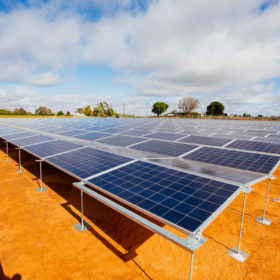
Jurchen Technology’s response to traditional solar module racking, the PEG, reduces the racking material needed, while cost-effectively simplifying the installation process and maximizing land utilization.
In an effort to simplify the solar installation process, Jurchen Technology has developed the PEG racking system: a racking system comprised of hot-tip galvanized steel bars with ground and top plates, on which the PV modules are installed. First installed globally in 2017, the PEG system was recently introduced to the U.S. market, following UL certification granted in mid-2019.
The system was designed to be constructed using only hand tools. Additionally, there are no rails, as the module’s frame is utilized as part of the substructure.
The system’s heaviest component is only ~5.5 lbs (2.5 kg) and the total system weight is ~26.5 lbs/kWp (~12kg/kWp), which is roughly 75% less than tracker systems and ~50% less than other fixed-tilt substructure. No foundations or DC trenching is required, as the frame’s steel posts are rammed into the ground and the DC cables are fixed to the substructure (see cable management photo).
The system’s 8 degree east-west orientation and its low profile (standing 0.85 meters above ground) eliminates the shading effect while allowing for the installation of very large blocks of up to 30 meters x 40 meters, with 1-meter walking paths between the blocks for maintenance purposes. This design implies an extremely large land cover of ~0.7 MW/acre, assuming 380 W modules, which is significantly larger than other systems where the land cover is generally around 0.23 MW/acre.
The large land cover allows developers to design projects that would otherwise not be possible due to land constraints.
This is especially apparent in the commercial solar space and utility projects connected to the distribution network where land parcels are usually smaller and more expensive and visual constraints are imposed by local authorities and neighbors adjust to the site.
This design offers significant capital expenditure reductions on the supply, delivery, logistics and installation of the system. Jurchen has found that PEG capital expenditure costs are roughly two-thirds of traditional single-axis tracker systems.
Suppliers have gone so far as to reference the building of PEG projects as being an EPI process, rather than EPC, suggesting ‘Installation’ over ‘Construction’ as a more appropriate way to describe the system’s assembly.
The installation process
Rods are rammed into the ground to a depth of 0.6 to 0.8 meters underground without concrete. DC cables are all above ground, and those system characteristics together with the system’s light weight eliminate the need for heavy machinery during the DC installation.
The system’s low profile and the large block architecture allow for ground-level module cleaning, which is more efficient than other systems, where the cleaning equipment has to be transported between less modules across more land area blocks.
***
Photo credits to Meralli Projects (https://ift.tt/2Oeh5Gq) and Belectric (www.belectric.com)
Lắp đặt điện mặt trời Khải Minh Tech
https://ift.tt/2X7bF6x
0906633505
info.khaiminhtech@gmail.com
80/39 Trần Quang Diệu, Phường 14, Quận 3
Lắp đặt điện mặt trời Khải Minh Tech
https://ift.tt/2ZH4TRU




Không có nhận xét nào:
Đăng nhận xét